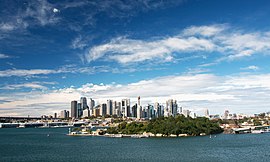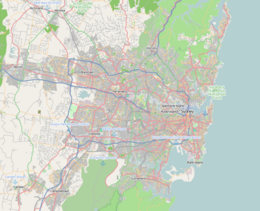Native name: Memel; Me-Mel | |
|---|---|
 Goat Island, viewed from Balls Head | |
Location of Goat Island in Greater Sydney | |
| Geography | |
| Location | Port Jackson |
| Coordinates | 33°51′08″S 151°11′48″E / 33.8521°S 151.1966°E |
| Area | 5.4 ha (13 acres) |
| Length | 180 m (590 ft) |
| Width | 300 m (1000 ft) |
| Administration | |
Australia | |
| Demographics | |
| Population | 5 |
| Goat Island | |
|---|---|
| Location | Port Jackson, Sydney, New South Wales, Australia |
| Built | 1826–1994 |
| Architect | Edmund Blacket; Alexander Dawson (Colonial Magazine) |
| Owner | NSW Office of Environment and Heritage |
| Official name | Goat Island; Me-Mel (the eye) |
| Type | State heritage (landscape) |
| Designated | 2 April 1999 |
| Reference no. | 989 |
| Type | Other - Landscape - Cultural |
| Category | Landscape - Cultural |


Goat Island is a heritage-listed island located in Port Jackson, in Sydney, New South Wales, Australia. Located northwest of the Sydney central business district, Goat Island is about 300m wide in a north/south direction and 180m long in an east/west direction; and covers an area of 5.4 hectares (13 acres).[1][2] Goat Island lies off the shores of the Sydney suburbs of Balmain and Millers Point, at the junction of Darling Harbour with the main channel of Sydney Harbour.
The island is a former gunpowder storage, arsenal, bacteriology station, shipyard, powder magazine, maintenance facility and accommodation and now interpretation centre and education facility. Over the years Goat Island has served as a quarry, convict stockade, explosives store, police station, fire station, boatyard and film set. Today the island forms part of the Sydney Harbour National Park. The built facilities on the island were designed by Edmund Blacket and Alexander Dawson and built from 1826 to 1994. Goat Island is also known as Memel or Me-Mel, meaning the eye. The property is owned by the NSW Office of Environment and Heritage, an agency of the Government of New South Wales. It was added to the New South Wales State Heritage Register on 2 April 1999.[3]
- ^ "GOAT ISLAND CONSERVATION MANAGEMENT PLAN" (PDF). Office of Environment & Heritage. p. 53. Retrieved 6 January 2015.
- ^ Gilchrist, Catie (2014). "Goat Island". Dictionary of Sydney. Dictionary of Sydney Trust. Retrieved 13 September 2014.
- ^ "Goat Island". New South Wales State Heritage Register. Department of Planning & Environment. H00989. Retrieved 2 June 2018.
 Text is licensed by State of New South Wales (Department of Planning and Environment) under CC BY 4.0 licence.
Text is licensed by State of New South Wales (Department of Planning and Environment) under CC BY 4.0 licence.
